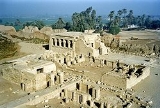
Dendera Temple complex
Encyclopedia
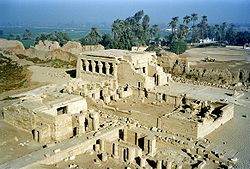
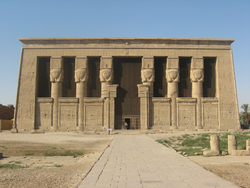
Dendera
Dendera is a small town in Egypt situated on the west bank of the Nile, about 5 km south of Qena, on the opposite side of the river.-History:...
, Egypt
Egypt
Egypt , officially the Arab Republic of Egypt, Arabic: , is a country mainly in North Africa, with the Sinai Peninsula forming a land bridge in Southwest Asia. Egypt is thus a transcontinental country, and a major power in Africa, the Mediterranean Basin, the Middle East and the Muslim world...
. It is one of the best-preserved temple
Egyptian temple
Egyptian temples were built for the official worship of the gods and commemoration of pharaohs in Ancient Egypt and in regions under Egyptian control. These temples were seen as houses for the gods or kings to whom they were dedicated...
complexes in Egypt. The area was used as the sixth Nome
Nome (Egypt)
A nome was a subnational administrative division of ancient Egypt. Today's use of the Greek nome rather than the Egyptian term sepat came about during the Ptolemaic period. Fascinated with Egypt, Greeks created many historical records about the country...
of Upper Egypt
Upper Egypt
Upper Egypt is the strip of land, on both sides of the Nile valley, that extends from the cataract boundaries of modern-day Aswan north to the area between El-Ayait and Zawyet Dahshur . The northern section of Upper Egypt, between El-Ayait and Sohag is sometimes known as Middle Egypt...
, south of Abydos
Abydos, Egypt
Abydos is one of the most ancient cities of Upper Egypt, and also of the eight Upper Nome, of which it was the capital city. It is located about 11 kilometres west of the Nile at latitude 26° 10' N, near the modern Egyptian towns of el-'Araba el Madfuna and al-Balyana...
.
Description

Eighteenth dynasty of Egypt
The eighteenth dynasty of ancient Egypt is perhaps the best known of all the dynasties of ancient Egypt...
(ca 1500 BC). But the earliest extant building in the compound today is the Mammisi
Mammisi
Mammisi is a term used for a small chapel attached to a larger temple, and associated with the nativity of a god. The word is derived from Coptic. Its usage is attributed to Jean-François Champollion. The most important surviving examples are from the Ptolemaic and Roman periods in Egypt....
raised by Nectanebo II
Nectanebo II
Nectanebo II was the third and last pharaoh of the Thirtieth dynasty, as well as the last native ruler of Ancient Egypt. Under Nectanebo II Egypt prospered...
– last of the native pharaohs (360-343 BC). The features in the complex include
- Hathor temple (the main temple),
- Temple of the birth of Isis,
- Sacred Lake,
- Sanatorium,
- Mammisi of Nectanebo II,
- Christian Basilica,
- Roman Mammisi,
- a Bark shine,
- Gateways of DomitianDomitianDomitian was Roman Emperor from 81 to 96. Domitian was the third and last emperor of the Flavian dynasty.Domitian's youth and early career were largely spent in the shadow of his brother Titus, who gained military renown during the First Jewish-Roman War...
& TrajanTrajanTrajan , was Roman Emperor from 98 to 117 AD. Born into a non-patrician family in the province of Hispania Baetica, in Spain Trajan rose to prominence during the reign of emperor Domitian. Serving as a legatus legionis in Hispania Tarraconensis, in Spain, in 89 Trajan supported the emperor against...
and - the Roman Kiosk.
Hathor temple


Trajan
Trajan , was Roman Emperor from 98 to 117 AD. Born into a non-patrician family in the province of Hispania Baetica, in Spain Trajan rose to prominence during the reign of emperor Domitian. Serving as a legatus legionis in Hispania Tarraconensis, in Spain, in 89 Trajan supported the emperor against...
. The existing structure was built no later than the late Ptolemaic period
Ptolemaic Egypt
Ptolemaic Egypt began when Ptolemy I Soter invaded Egypt and declared himself Pharaoh of Egypt in 305 BC and ended with the death of queen Cleopatra VII of Egypt and the Roman conquest in 30 BC. The Ptolemaic Kingdom was a powerful Hellenistic state, extending from southern Syria in the east, to...
. The temple, dedicated to Hathor
Hathor
Hathor , is an Ancient Egyptian goddess who personified the principles of love, beauty, music, motherhood and joy. She was one of the most important and popular deities throughout the history of Ancient Egypt...
, is one of the best preserved temples in all Egypt. Subsequent additions were added in Roman times.
Layout elements of the Temple
- Large Hypostyle Hall
- Small Hypostyle Hall
- Laboratory
- Storage Magazine
- Offering Entry
- TreasuryTreasuryA treasury is either*A government department related to finance and taxation.*A place where currency or precious items is/are kept....
- Exit to Well
- Access to Stairwell
- Offering Hall
- Hall of the EnneadEnneadThe Ennead was a group ofnine deities in Egyptian mythology. The Ennead were worshipped at Heliopolis and consisted of the god Atum, his children Shu and Tefnut, their children Geb and Nut and their children Osiris, Isis, Horus, Set and Nephthys.-Terminology:Egyptian mythology established multiple...
- Great Seat and Main Sanctuary
- Shrine of the Nome of Dendera
- Shrine of IsisIsisIsis or in original more likely Aset is a goddess in Ancient Egyptian religious beliefs, whose worship spread throughout the Greco-Roman world. She was worshipped as the ideal mother and wife as well as the matron of nature and magic...
- Shrine of Sokar
- Shrine of Harsomtus
- Shrine of Hathor's SistrumSistrumA sistrum is a musical instrument of the percussion family, chiefly associated with ancient Iraq and Egypt. It consists of a handle and a U-shaped metal frame, made of brass or bronze and between 76 and 30 cm in width...
- Shrine of gods of lower Egypt
- Shrine of HathorHathorHathor , is an Ancient Egyptian goddess who personified the principles of love, beauty, music, motherhood and joy. She was one of the most important and popular deities throughout the history of Ancient Egypt...
- Shrine of the Throne of Rê
- Shrine of RêReRe, bre, moré is an interjection common to Cypriot Greek, the languages of the Balkans, Turkish, and Venetian, with its "locus... more in the Greek world than elsewhere". It is used in colloquial speech to gain someone's attention, add emphasis, insult, or express surprise or astonishment, like...
- Shrine of Menat collar
- Shrine of IhyIhyIhy is a god in ancient Egyptian mythology who represents the ecstasy of playing the sistrum. His name may mean "sistrum player", referring to his function, or "calf", alluding to his relationship with the cow goddess Hathor who was often said to be his mother. Other goddesses might be called his...
- The Pure Place
- Court of the First Feast
- Passage
- Staircase to Roof
Depictions of Cleopatra VI which appear on temple walls are good examples Ptolemaic Egyptian art. One depicts Cleopatra and her son, Caesarion
Caesarion
Ptolemy XV Philopator Philometor Caesar , better known by the nicknames Caesarion and Ptolemy Caesar , was the last king of the Ptolemaic dynasty of Egypt, who reigned jointly with his mother Cleopatra VII of Egypt, from September 2, 44 BC...
. On the rear of the temple exterior is a carving of Cleopatra VII Philopator and her son, Ptolemy XV Philopator Philometor Caesar, fathered by Julius Caesar
Julius Caesar
Gaius Julius Caesar was a Roman general and statesman and a distinguished writer of Latin prose. He played a critical role in the gradual transformation of the Roman Republic into the Roman Empire....
.
Dendera zodiac
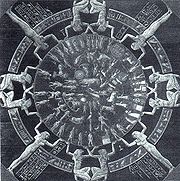
The sculptured Dendera zodiac (or Denderah zodiac) is a widely known relief found in a late Greco-Roman temple, containing images of Taurus
Taurus (astrology)
Taurus is the second astrological sign in the Zodiac, which spans the zodiac between the 30th and 59th degree of celestial longitude. Generally, the Sun transits this area of the zodiac between April 21 to May 21 each year...
(the bull
Bull
Bull usually refers to an uncastrated adult male bovine.Bull may also refer to:-Entertainment:* Bull , an original show on the TNT Network* "Bull" , an episode of television series CSI: Crime Scene Investigation...
) and the Libra
Libra (astrology)
Libra is the seventh astrological sign in the Zodiac, originating from the constellation of Libra. In astrology, Libra is considered a "masculine", positive sign. It is also considered an air sign and is one of four cardinal signs...
(the balance). A sketch was made of it during the Napoleonic campaign in Egypt. and in 1820 it was removed from the ceiling and is now in the Louvre. Champollion's guess that it was Ptolemaic proved correct and Egyptologists now date it to the first century BC.
Necropolis and crypts
The Dendera necropolis is a series of mastabaMastaba
A mastaba, or "pr-djt" , is a type of ancient Egyptian tomb in the form of a flat-roofed, rectangular structure with outward sloping sides that marked the burial site of many eminent Egyptians of Egypt's ancient period...
tomb
Tomb
A tomb is a repository for the remains of the dead. It is generally any structurally enclosed interment space or burial chamber, of varying sizes...
s. The necropolis
Necropolis
A necropolis is a large cemetery or burial ground, usually including structural tombs. The word comes from the Greek νεκρόπολις - nekropolis, literally meaning "city of the dead"...
dates from the Early Dynastic Period
Early Dynastic Period of Egypt
The Archaic or Early Dynastic Period of Egypt immediately follows the unification of Lower and Upper Egypt c. 3100 BC. It is generally taken to include the First and Second Dynasties, lasting from the Protodynastic Period of Egypt until about 2686 BC, or the beginning of the Old Kingdom...
of the Old Kingdom
Old Kingdom
Old Kingdom is the name given to the period in the 3rd millennium BC when Egypt attained its first continuous peak of civilization in complexity and achievement – the first of three so-called "Kingdom" periods, which mark the high points of civilization in the lower Nile Valley .The term itself was...
to the First Intermediate Period of Egypt
First Intermediate Period of Egypt
The First Intermediate Period, often described as a “dark period” in ancient Egyptian history, spanned approximately one hundred years after the end of the Old Kingdom from ca. 2181-2055 BC. It included the seventh, eighth, ninth, tenth, and part of the eleventh dynasties. Very little monumental...
. The necropolis runs the eastern edge of the western hill and over the northern plain. The subterranean Hathor temple tombs total 12 chambers. Some reliefs are dated to as late as Ptolemy XII Neos Dionysos reign. The crypt
Crypt
In architecture, a crypt is a stone chamber or vault beneath the floor of a burial vault possibly containing sarcophagi, coffins or relics....
s reportedly were used for storing vessels and divine iconography. An opening in the "Flame Room" floor leads to a narrow chamber with representations on the walls of the objects which were kept in them. In the second chamber, a relief depicts Phiops of the Sixth Dynasty. He holds a statuette of the Ihi
Ihi
Ihi, Ehee or Bel Marriage is a ceremony in the Newar community in Nepal in which pre-adolescent girls are 'married' to the bel fruit , which is a symbol of the god Vishnu, ensuring that the girl becomes and remains fertile...
to four images of Hathor. In the crypt, reached from the "Throne room", Ptolemy XII has jewelry and offerings for the gods.
The Dendera light
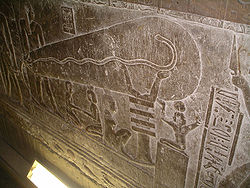
Dendera light
The "Dendera light" is a term used to describe a supposed ancient Egyptian electrical lighting technology depicted on three stone reliefs in the Hathor temple at the Dendera Temple complex located in Egypt...
because of a controversial fringe thesis about its nature. The Dendera light images comprise five stone reliefs (two of which contain a pair of "lights") in the Hathor temple at the Dendera Temple complex located in Egypt
Egypt
Egypt , officially the Arab Republic of Egypt, Arabic: , is a country mainly in North Africa, with the Sinai Peninsula forming a land bridge in Southwest Asia. Egypt is thus a transcontinental country, and a major power in Africa, the Mediterranean Basin, the Middle East and the Muslim world...
. The view of Egyptologists is that the relief is a mythological
Egyptian mythology
Ancient Egyptian religion was a complex system of polytheistic beliefs and rituals which were an integral part of ancient Egyptian society. It centered on the Egyptians' interaction with a multitude of deities who were believed to be present in, and in control of, the forces and elements of nature...
depiction of a djed
Djed
The djed symbol is a pillar-like ancient Egyptian symbol representing stability. It has been interpreted as the backbone of the Egyptian god Osiris, especially in the form Banebdjedet . Djedu is the Egyptian name for Busiris, a centre of the cult of Osiris...
pillar and a lotus
Nymphaea caerulea
Nymphaea caerulea, also known as the Blue Egyptian water lily or sacred blue lily, is a water-lily in the genus Nymphaea.-Distribution:Its original habitat may have been along the Nile and other locations in East Africa...
flower, spawning a snake within, representing aspects of Egyptian mythology
Egyptian mythology
Ancient Egyptian religion was a complex system of polytheistic beliefs and rituals which were an integral part of ancient Egyptian society. It centered on the Egyptians' interaction with a multitude of deities who were believed to be present in, and in control of, the forces and elements of nature...
.
In contrast to this interpretation, there is a fringe science
Fringe science
Fringe science is scientific inquiry in an established field of study that departs significantly from mainstream or orthodox theories, and is classified in the "fringes" of a credible mainstream academic discipline....
suggestion that departs significantly from the views of Egyptologists
Egyptology
Egyptology is the study of ancient Egyptian history, language, literature, religion, and art from the 5th millennium BC until the end of its native religious practices in the AD 4th century. A practitioner of the discipline is an “Egyptologist”...
arguing that it is actually a representation of an Ancient Egyptian lightbulb.
Tourism
The Dendera complex has long been one of the most tourist accessible ancient Egyptian places of worship. It used to be possible to visit virtually every part of the complex, from the crypts to the roof. Unfortunately the highest part of the roof of Hathor temple has been closed since 2003. The second stage of the roof was closed in November 2004, after a tourist got too close to the edge and fell to her death on the bedrock below.See also
- Esna temple (in EsnaEsnaEsna , known to the ancient Egyptians as Egyptian: Iunyt or Ta-senet; Greek: or or ; Latin: Lato, is a city in Egypt. It is located on the west bank of the River Nile, some 55 km south of Luxor...
) - Egyptian mythologyEgyptian mythologyAncient Egyptian religion was a complex system of polytheistic beliefs and rituals which were an integral part of ancient Egyptian society. It centered on the Egyptians' interaction with a multitude of deities who were believed to be present in, and in control of, the forces and elements of nature...
- List of Ancient Egyptian sites

